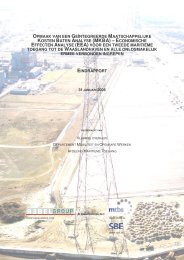Hoorzitting – 9 juni 2009 Verslag - Deurganckdoksluis
Hoorzitting – 9 juni 2009 Verslag - Deurganckdoksluis
Hoorzitting – 9 juni 2009 Verslag - Deurganckdoksluis
Create successful ePaper yourself
Turn your PDF publications into a flip-book with our unique Google optimized e-Paper software.
concentration of ground‐level ozone in Europe and the role of ships' emissions of NOx in exceeding<br />
the critical loads of nutrient nitrogen.<br />
Preventive measures deployed<br />
At the international level, Annex VI of the MARPOL Convention (adopted by the International<br />
Maritime Organisation in 1997, but not yet in force) sets regulations for the prevention of air<br />
pollution by ships. The Kyoto Protocol also calls for the reduction of greenhouse gas emissions from<br />
ships.<br />
To date, the bulk of Community legislation on atmospheric emissions does not apply to ships. As a<br />
result, in the European Union, ship emissions are higher than other land‐based transport emissions.<br />
For example, by 2010, SO2 emission from ships in European waters are likely to account for 75 % of<br />
all emissions from EU land‐based sources. There are, however, a number of Community measures<br />
requiring the Commission to take action on ship emissions:<br />
• Directive 2001/81/EC on national emission ceilings for certain atmospheric pollutants<br />
commits the Commission to report on the extent to which emissions from maritime traffic<br />
contribute to acidification, eutrophication and the formation of ground‐level ozone;<br />
• Directive 1999/32 relating to a reduction in the sulphur content of certain liquid fuels sets<br />
sulphur limits for marine distillate oil used in EU territorial waters;<br />
• Directive 94/63/EC on the control of volatile organic compound (VOC) emissions resulting<br />
from the storage of petrol and its distribution from terminals to service stations [Official<br />
Journal L 365 of 31.12.1994] provides that the Commission must consider extending the<br />
scope of the Directive to include the loading and unloading of ships;<br />
• Regulation (EC) No 2037/2000 on substances that deplete the ozone layer bans the<br />
marketing and use of ozone‐depleting substances in the EU;<br />
• The Clean Air for Europe (CAFE) Programme tackles all sources of atmospheric emissions;<br />
• The sixth Environment Action Programme: one of the objectives of 6EAP is to achieve levels<br />
of air quality that do not have unacceptable effects on human health and the environment,<br />
and to stabilise greenhouse gases emissions in order to prevent unnatural variations of the<br />
earth's climate.<br />
In recent years, economic instruments have been introduced in some countries and ports around the<br />
world to encourage ships to reduce their atmospheric emissions. These include differential taxes on<br />
marine fuels, differentiated port and fairway dues, and differentiated tonnage taxes.<br />
Strategy objectives and actions<br />
The objectives of the strategy are:<br />
• to reduce ships' emissions of SO2 where they contribute to critical loads for acidification<br />
being exceeded, and where they affect local air quality;<br />
23




